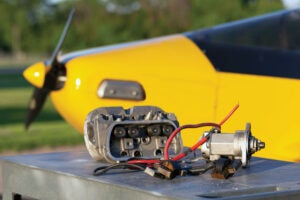
Confronted with a large task, we often see the whole of it and can’t get started. Cleaning a garage comes to mind. The door goes up, eyes scan 10 years of stuff and the door goes back down. In my column “Narrowed Focus,” (Kitplanes®, January 2019) I described a technique I use to reduce large, intimidating tasks into smaller, easily accomplished tasks. It works when staring at a plans page covered in more ink than a latte-slinging hipster. It works when wiring an airframe. And, because knowledge never exists in a vacuum, it works for home maintenance as well as homebuilding. I used the technique to get started on the daunting task of stripping and repainting weather-beaten windows on my house. After completing the first mini-task—gathering scraping and sanding tools—I felt so accomplished and encouraged by my progress that I, well…I went for a motorcycle ride.
The narrowed-focus technique—valuable for spurring progress on a large task—can get us stuck in place, even moving backward, when problems arise. We focus on what we think is wrong and move quickly to implement a fix. That is tunnel vision. Who hasn’t spent considerable effort trying to start an engine before making sure the fuel valve was on? (Only me? Really?) Narrowed focus is intentional. Tunnel vision, which is what we often experience when troubleshooting, is unintentional and often defeating.
A Failure to Triumph
I was preparing a Triumph TR6 for a road trip and decided a full tune-up was due. (Hang in here with me, as I wrote earlier, knowledge doesn’t exist in a vacuum. Triumphs taught me much about building airplanes, particularly troubleshooting). The car was running well but I knew it could run better, even if the benefits played out more in my imagination than in actual performance gains. The tune-up included torquing the cylinder head and setting the valves (always in that order), changing the oil, and installing new air cleaners, spark plugs, rotor and distributor cap. The ignition timing was checked and adjusted. The distributor’s points had been replaced with an electronic ignition system, therefore the routine task of setting point gap was no longer necessary. Finally, because carburetor adjustments always come last, I tuned and synchronized the dual Strombergs. The tune-up was equal parts communion and precaution.
When I was done, I pulled the choke knob and turned the key. The car started and loped as it does when it is cold and rich. I envisioned clean oil bathing the inside of the engine; the parts rejoicing as plants rejoice when a summer rain washes away the dust of a drought. I eased the choke knob in. The engine stumbled and quit. Repeated attempts gave the same results. Clearly, I had erred somewhere. The Stromberg twins were first to draw my gaze (see “The Usual Suspect: The Misfire,” KITPLANES®, September 2019). Repeated carburetor adjustments—many done out of frustration on the “I’ll try this and see” approach to tuning rather than based on solid cause-and-effect reasoning—failed to eliminate the problem. I double-checked everything: valve settings, ignition timing, the distributor cap, spark plug wire routing and security. Throughout the troubleshooting exercise, I found the engine’s behavior remained unchanged. My trip was only days away. I was out of time and out of ideas. I delivered the car to a shop whose back lot was filled with the skeletons of British cars. Like headstones, their license plates bore witness to the year of their demise.
I passed the following day preparing for a smug mechanic with Castrol-stained fingers and a comprehensive collection of Whitworth wrenches and King Dick spanners to tell me the care of a British car should not be attempted by a colonial. Instead, I was told the cause was a loose ground wire between the distributor’s aftermarket electronic ignition and the engine block. He said my tune-up efforts were spot-on. I paid the bill and left with a smooth-running car and an advanced degree in maintenance and troubleshooting. The ground wire, which hung like a suspension bridge between the distributor and the engine block under the spark plug wires I had removed and replaced, was not given attention during the tune-up. Because that wire was not given my attention during the tune-up, it didn’t get my attention while I tried to resolve the problem. The shop found it because they weren’t narrowly focused on the maintenance I had performed, they were broadly focused on finding the problem.
A Tall Tail
This story brings us back to homebuilding. A builder fitting a fiberglass tip to the stub rudder of a Waiex questioned whether it needed to be trimmed because it interfered with the ruddervator when both were fully deflected. Interference shouldn’t exist in that location, shouldn’t even be possible. I asked for photos. They showed the problem was not the rudder’s tip, it was a ruddervator mounted incorrectly on the stabilizer. The builder, not surprisingly, believed the problem was the rudder’s tip as that is what he was working on when the interference occurred. The ruddervator was overlooked because it had been installed without incident—though incorrectly—days, weeks or even months earlier.
When a problem arises, it can be difficult to step back and objectively assess the cause. The more time spent trying to resolve a problem, the more likely tunnel vision is keeping the actual cause out of sight. Just as a mechanic needed to find the loose ground wire on my car, and I needed to see the incorrectly installed ruddervator on another builder’s airplane, we sometimes need fresh, unbiased eyes to solve a problem that has us stuck. A narrowed focus can get you moving forward on a new or large task. Tunnel vision can get you stuck trying to resolve a problem.













